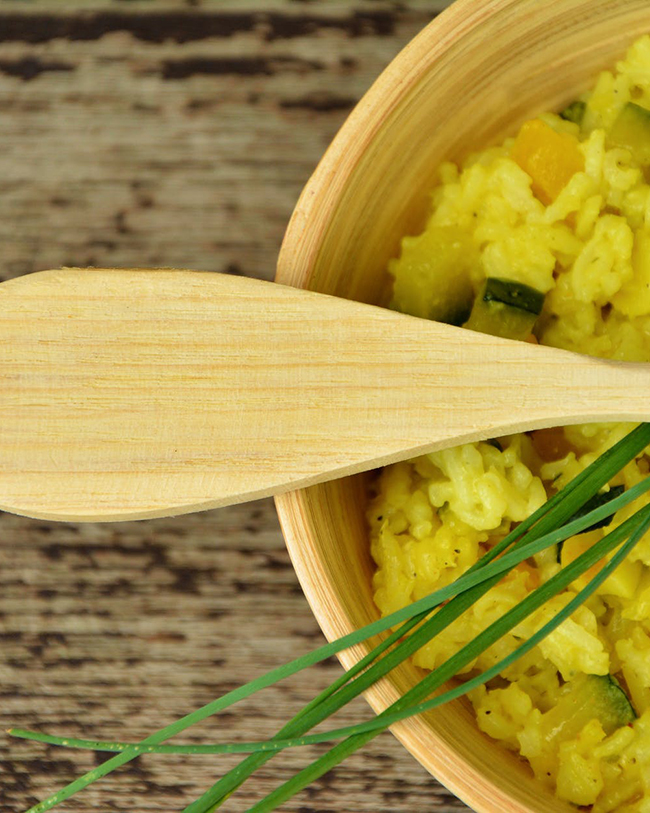Healthy Eating
Enjoy this wonderfully balancing recipe along with food meditation practices.
Kichari
Kichari is a main staple of any panchakarma or panchakarma preparation. This is a detoxifying and cooling mixture of mung dal and rice covered with spiced ghee called vagar. There are countless variations to the recipe, depending on your body, needs and season. Consult with an Ayurvedic Practitioner to learn how to customize the basic recipe listed below.
Kitchari is a main staple of any panchakarma or panchakarma preparation. This is a detoxifying and cooling mixture of mung dal and rice covered with spiced ghee called vagar. There are countless variations to the recipe, depending on your body, constitutional needs and season.
Ingredients
1c White Basmati rice
1c Mung Daal
4-5c Liquid (bone broth, water
5 Tbs Ghee
1 tsp Cumin
1 tsp Coriander
1 tsp Turmeric
1 tsp Fennel
1 tsp Mustard seeds
salt to taste
*additional vegetables, according to your needs
STEP 1
Rinse the rice and dal in warm water.
*Optional: Soak your grains in water if you like, this will soften the grains and dal as they cook. If you soak, only do so for about 30-60 minutes. Soaking the grains and beans neutralizes the phytic acids contained within them. Since phytic acids bind to minerals like iron and are indigestible, neautralizing the acid by soaking increases your ability to absorb then nutrients better.
STEP 2
Using a large ceramic pot, bring the grains, dal and cooking liquid to a steady, gentle boil. Using a medium-low heat will help foster a steady, neutral energy in your food and this will transfer into your body as you eat.
STEP 3
Add your veggies (NOT THE LEAFY GREENS!) directly into the pot. Cover the pot with a lid and leave for 20-30 minutes, turn heat o when the water is fully absorbed.
*This is a fast and easy way to cook your kitchari! The rice, dal and veggies (such as carrots, beets, potatoes, etc.) will all cook together in the same pot.
STEP 4
Make your vagar. In a separate pot (cast iron works best). Heat the ghee over medium heat. Add your spices. When the mustard seeds start to pop, turn o the heat and remove pot from stove.
STEP 5
Add your leafy greens to the top of your pot of cooked rice, dal, and veggies.
STEP 6
Pour the hot vagar over the top of the leafy greens. Be careful for popping spices! This is a really nice way to ash fry your leafy greens and mix the spiced ghee into the rice and veggies.
STEP 7
Mix all together and serve with yogurt, salt, or nutritional yeast.
Six Tastes of Ayurveda
It’s very important that all six taste are represented in your kichari. This helps our mind and body maintain equilibrium, as taste has a direct effect in the direction our mind goes as well as the elements our body accumulates. The six Ayurvedic taste are:
- Sweet
- Salty
- Sour
- Pungent
- Bitter
- Astringent
Most of the ingredients will represent more then one taste. Grains in general are sweet. Mung Dal is both sweet and astringent. Add just a pinch or 2 of sea salt, for a saltier taste. Fresh ginger is one of the best for pungent tastes but be carful not to go to far
with pungent, just a taste. Bitter is best represented by greens. Our favorite are Dandelions which are so good for cooling pitta and cleaning the blood. Last but not least a dollop of plain yogurt for the sour taste. The yogurt completes the meal.
Food Meditation
As you eat your kichari it’s important to be aware of a few very basic healthy eating Ayurvedic principles. The amount of awareness you have as you eat your food can be more important than what you are actually eating. We could eliminate so much of our dis-eases if we could all look at our meals as an opportunity to practice awareness meditation. Here are some things you can practice with:
1) Take a moment to fully appreciate your food. A few deep breaths, perhaps a prayer or mantra. Think about where your food comes from. Give thanks to all that contributed to fill your belly so good!
2) Eat in a calm environment. No television or radio. No heavy conversations try to just experience the joy of the food and the medicine it contains.
3) Chew your food thoroughly. Saver every bite, every taste that you experience.
4) Do not drink a lot of liquid with your food. Meal times are not the times to hydrate. Your stomach acids do a much more effective job undiluted by to much water. If you do need something to wash it down try to drink liquids at body temperature and sparingly.
5) Only eat until your 75% full, this is about the size of your 2 hands cupped together. Allow for a little space in your belly for the food to properly churn around. This will increase your ability to actually absorb nutrient properly and make sure that nothing sits in your belly to long and starts to ferment causing the formation of Ama.
6) The body has different stages of digestions and in order to find optimal harmony with those stages, it’s best toeat your sweets first. Your bitter and astringent flavors come last. This has to do with pH levels in the belly that go through a cycle as soon as we begin to eat.
And there you have it, your basic kichari! For tips on how to customize this recipe according to your needs, body and season, get in touch with an Ayurvedic Practitioner at Wasatch Ayurveda and Yoga Upstairs.
